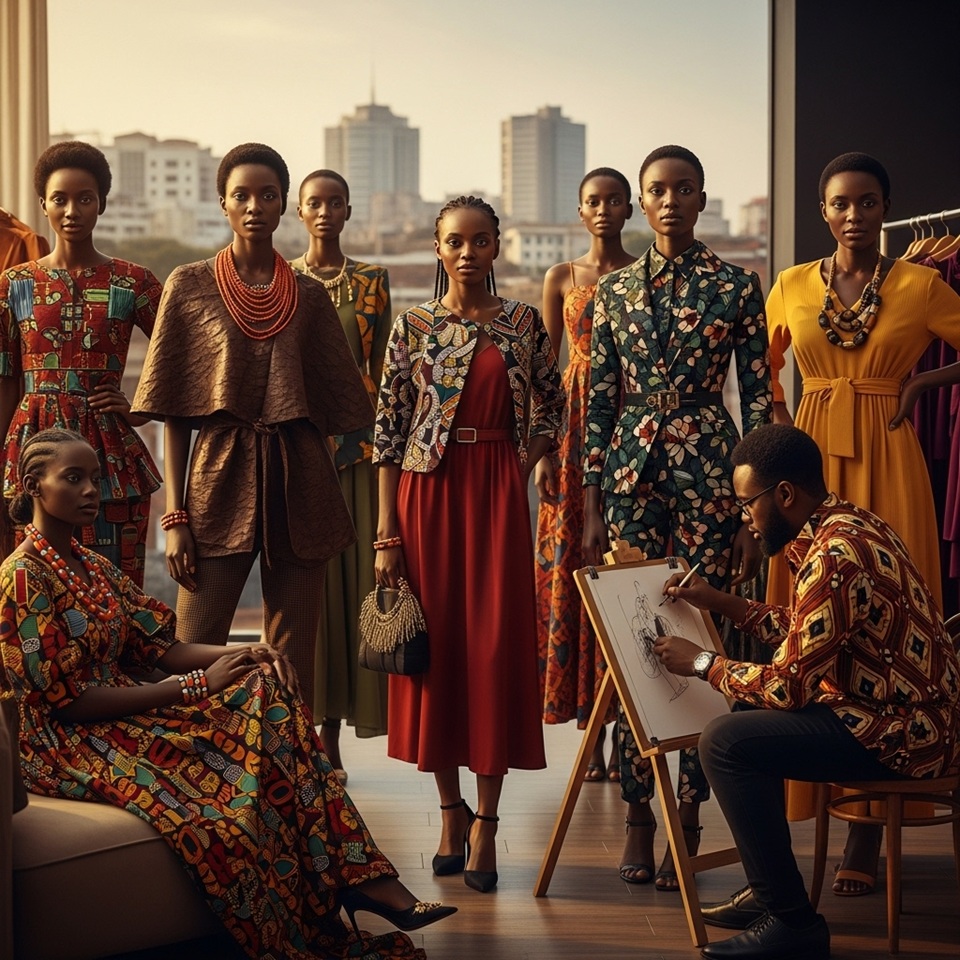African Designers in Kampala: Weaving Culture, Creativity, and Couture
Kampala, the vibrant heartbeat of Uganda, is fast becoming the fashion epicenter of East Africa. The city’s streets hum with energy, a lively blend of tradition and innovation. At the core of this stylistic renaissance are African designers in Kampala, whose creations narrate stories of identity, heritage, and bold modernity. These designers are stitching together ancestral inspiration with global trends, and in doing so, they’re not just dressing Kampala—they’re dressing the world.
In this article, we explore how Kampala’s fashion scene has evolved, spotlighting the leading voices in the industry, and examining how African designers in Kampala are shaping global conversations on style, sustainability, and cultural representation.
The Rise of Kampala as a Fashion Hub
Kampala’s creative scene has blossomed over the last decade. From hosting high-profile fashion events like the Kampala Fashion Week to the opening of luxury boutiques and artisan markets, the city has seen a surge in appreciation for homegrown talent. Kampala now stands shoulder to shoulder with Nairobi, Johannesburg, and Lagos as a fashion capital of Africa.
At the heart of this movement are designers who are reimagining African aesthetics with modern sensibilities. They are using indigenous fabrics like kitenge, bark cloth, and kikoy while embracing minimalist cuts, sustainable materials, and international trends.
Trailblazers: African Designers in Kampala Leading the Charge
1. Anita Beryl – Beryl Couture
A luminary in Kampala’s fashion world, Anita Beryl, the creative force behind Beryl Couture, has made headlines for her intricate bridal and eveningwear collections. Her pieces blend African glamour with global sophistication, often featuring beaded embroidery and luxe fabrics. Her designs are a staple on Kampala red carpets and international runways alike.
“Each piece tells a story of African elegance and confidence. I want every woman who wears Beryl to feel like royalty,” says Anita.
2. Jose Hendo – Eco-Sustainable Design Icon
Renowned for championing sustainable fashion, Jose Hendo brings a refreshing depth to Kampala’s design scene. Her “Bark to the Roots” collection—made from bark cloth—received global recognition and shone a light on eco-conscious African fashion.
Hendo’s work speaks to a broader conversation about heritage, environmental responsibility, and ethical production, which is increasingly central in the fashion world.
3. Ras Kasozi – Streetwear and Urban Expression
Known for his edgy street-style pieces, Ras Kasozi fuses hip-hop aesthetics with traditional Ugandan influences. His bold prints, unconventional silhouettes, and commentary on social issues make his collections deeply personal and politically aware.
Kasozi’s label, Kas Wear, resonates with Kampala’s youth and reflects the city’s cultural dynamism.
4. Martha Jabo – Redefining Feminine Fashion
Martha Jabo’s sleek, chic, and sensual garments have positioned her as one of Kampala’s foremost names in women’s fashion. Her cuts are minimalist, her palette often monochrome, yet every piece exudes power and grace.
She caters to the modern African woman—confident, career-driven, and unapologetically stylish.
5. Kkoolo – The Fusion House
Founded by fashion artist Alex Alecool, Kkoolo is not just a brand—it’s a lifestyle. Known for gender-fluid collections and avant-garde presentation, Kkoolo represents the intersection of art, activism, and fashion in Kampala.
Each Kkoolo runway show feels more like a performance, tackling themes of mental health, gender identity, and social reform.
Where Tradition Meets Innovation
African designers in Kampala are not just preserving culture—they’re evolving it. Through their designs, you’ll find references to Uganda’s rich tapestry of tribes, from the Buganda to the Acholi, yet wrapped in modern silhouettes fit for Milan or Paris.
Kampala’s designers are architects of identity. They pull from their cultural archives and reimagine their histories in bold hues, dramatic tailoring, and culturally loaded motifs. A dress isn’t just a dress—it’s a canvas of ancestry, a walking museum, a political manifesto.
Challenges Facing Kampala’s Fashion Creatives
Like any burgeoning fashion capital, Kampala’s designers face a host of challenges:
-
Limited Access to Fabric: Many designers rely on imported textiles, which can drive up costs.
-
Infrastructure Gaps: A lack of local production facilities and inconsistent electricity hinder large-scale operations.
-
Global Competition: With fashion becoming more digital, Kampala’s designers must compete with international e-commerce giants.
Yet, these hurdles haven’t dulled their creativity. Instead, they’ve inspired local innovation—from hand-dyed textiles to collaborative fashion hubs—strengthening the city’s industry from within.
The Role of Fashion Education
Institutions like the Uganda Institute of Fashion and Design (UIFD) and Makerere University’s Art and Design School are nurturing the next generation of fashion professionals. These schools are ensuring that fashion is not just a creative pursuit, but a sustainable business venture.
Did you know? Many top Kampala designers now run mentorship programs and offer internships to emerging talent—paying it forward to cultivate a thriving design community.
Digital Influence and E-Commerce Growth
With Instagram boutiques, TikTok styling reels, and WhatsApp orders, Kampala’s designers are harnessing digital platforms to expand their reach. Fashion influencers and bloggers are helping to popularize local labels and elevate their visibility.
Some designers now sell globally through platforms like Afrodesiac Worldwide and Afrikrea, tapping into the diaspora’s demand for authentic African fashion.
Afrikrea – African Online Marketplace
Fashion Events That Elevate Kampala’s Style
Fashion weeks and pop-ups are more than showcases—they are networking arenas, talent discovery platforms, and export launchpads. Key events include:
-
Kampala Fashion Week
-
Afri Fashion Fest
-
Abryanz Style & Fashion Awards (ASFAs)
These events give designers the limelight they deserve and connect them to buyers, stylists, and media from across the globe.
A Cultural Fashion Renaissance in the Making
African designers in Kampala are not chasing trends—they are setting them. Their designs tell nuanced African stories with international relevance. The capital’s fashion movement is rich with potential: it’s a colorful rebellion against colonial fashion ideals, a nod to ancestral roots, and a blueprint for future global dominance.
Much like how jazz emerged from the soul of New Orleans and conquered the world, Kampala’s designers are creating a fashion language that is uniquely African, yet universally admired.
FAQs About African Designers in Kampala
1. Who are the most famous African designers in Kampala?
Anita Beryl, Ras Kasozi, Jose Hendo, Martha Jabo, and Kkoolo are among the top celebrated designers shaping Kampala’s fashion scene.
2. Where can I buy designs from Kampala-based African designers?
Many have Instagram stores, boutiques in the city, and online shops through platforms like Afrikrea or their own websites.
3. What materials do designers in Kampala use?
Designers often blend local fabrics like bark cloth and kitenge with international textiles to create fusion collections.
4. Are there fashion schools in Kampala?
Yes, notable ones include the Uganda Institute of Fashion and Design (UIFD) and Makerere University.
5. What is the Kampala Fashion Week?
It is an annual fashion event showcasing Ugandan and African designers, attracting local and international fashion lovers.
6. Is sustainable fashion big in Kampala?
Yes. Designers like Jose Hendo are global leaders in eco-sustainable African fashion.
7. How do I collaborate with African designers in Kampala?
Reach out via social media, attend local fashion events, or contact them through their official websites.
8. What inspires Kampala’s designers?
Their work is often inspired by Ugandan culture, politics, history, music, and the vibrancy of African life.
9. Are Kampala designers affordable?
There is a wide range—some cater to luxury markets, while others are accessible to everyday consumers.
10. How is technology influencing Kampala’s fashion scene?
Digital marketing, online sales platforms, and virtual fashion shows have amplified local designers’ global reach.
Conclusion
The fashion revolution in Uganda’s capital is not merely aesthetic—it is cultural, economic, and global. African designers in Kampala are crafting more than clothes; they are scripting new narratives for Africa on the global stage. As they stitch fabric, they also stitch stories of resilience, pride, and innovation—turning Kampala into a sartorial force to reckon with.
So next time you see a piece marked “Made in Uganda,” know that behind that label lies a legacy of passion, purpose, and the vibrant soul of Kampala.
Relevant Links
Internal Links






